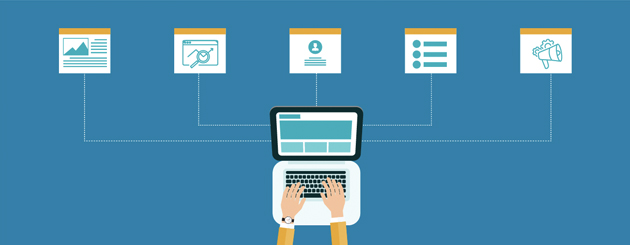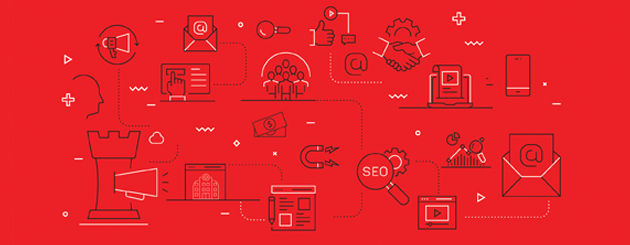



By John Lavey, President
We view helpful content as one of the highest forms of marketing. Helpful content is superior marketing to content that hypes a solution.
Sometimes the most helpful kind of content, particularly for B2B marketing, is educating your customers and creating resources that they can use to do their jobs more effectively.
Helping educate your audience to help them be better at their jobs can take many forms. Here are three ideas:
User conferences
Many of our clients host user conferences, assembling a curriculum to introduce customers to the latest and best ideas about their job. These two-day or three-day events are big lifts for companies to put on, and they can be expensive, but they are viewed positively by customers.
Client universities
Some clients we’ve worked with have adopted the idea of themselves as a university, continually teaching their customers how to be better at their job. When the customers are a channel seller of their solution, it’s not only helpful but also savvy. The university model differs from the user conference model to the extent that the teaching and the messaging last beyond the three-day span. The investment in that kind of marketing spans year round.
Library of resources
This kind of content marketing offers clients a library of resources to help them do their jobs. Providing presentation decks, e-books, videos and more, marked with their branding so they can use them in their marketing or sales to clients, is good content marketing.
How can you help teach your client and sharpen your content marketing?
About Hammock Healthcare Idea Email | This post is part of Hammock’s award-winning Idea Email series. Idea Emails are sent every other week and share one insightful marketing idea. Idea Email comes in two flavors: Original and Healthcare. To subscribe to the original Idea Email (general marketing ideas), click here. To subscribe to the Healthcare Idea Email (healthcare marketing ideas), click here.

By John Lavey, President
With the labor market as tight as it is, it has never been harder to attract and retain talent. If your company is like some, the move to remote work means that you are no longer just competing with companies in your geographic area; you are competing against the rest of the world for the best people in your industry.
Finding ways to stand out from the competition and truly engage potential candidates for hire is hard to do, but using video to assist your recruiting efforts is a dynamic way to meet that challenge.
Short videos that tell authentic stories about who you are and why someone would want to work with you right now can cut through the details you will likely have to share in a job posting.
Here are some of the tips for what you will want in an effective video to accompany your recruitment postings:
Short—The most popular format for viewing videos right now is on TikTok, and the sweet spot for length of video there is 7 seconds to 15 seconds. Chances are you can’t communicate the value of a role in a TikTok video, but you should aim for brevity. There are industry-specific and platform-specific standards, but getting a video to 1 minute is a good goal.
Authentic—Letting your passion come through about your mission as an organization and why you care about what you do is important. It’s not so much what you say as how you say it. That energy is contagious.
Clear—Get to the point quickly, or create a clear call to action about what they can do next if interested. The platforms themselves can provide an assist here. But if it’s important, for example, to make it clear whether you are open to remote work, say it out loud.
Storytelling content is a critical part of every stakeholder journey, not just your customer journeys. Think about how you can help your prospective employees at each stage of their search. Video can help.
Image: Getty Images
About Hammock Healthcare Idea Email | This post is part of Hammock’s award-winning Idea Email series. Idea Emails are sent every other week and share one insightful marketing idea. Idea Email comes in two flavors: Original and Healthcare. To subscribe to the original Idea Email (general marketing ideas), click here. To subscribe to the Healthcare Idea Email (healthcare marketing ideas), click here.

We often take it for granted that a content calendar is part of the value we provide healthcare clients, but being able to provide timely, consistent, relevant and highly engaging content requires planning, a structured slate of content and an accompanying schedule.
For social media, blog posts and content campaigns, having a content calendar helps you avoid duplicating content, saves you from last-minute (poor) planning, and helps you visualize your content strategy well into the future.
Our approach to creating content for healthcare clients means creating content in advance while allowing room for timely opportunities to respond to something newsworthy that captures the attention of the audience.
Our experience over time is clients need real-time visibility (or close to that) into the status of projects in the works. So, creating a schedule in a shared, collaborative platform can be the basis for a good workflow.
The calendar, combined with status updates and performance reporting, feeds best practices and a great partnership.
Most companies can’t create content effectively on their own. It’s too specialized and expensive to create content across media types, distribute across multiple channels, and measure to determine success.
If you are struggling to share the great stories you have to tell, consider what it will require to stay on track. A content calendar is a wonderful start.
Image: Getty Images
About Hammock Healthcare Idea Email | This post is part of Hammock’s award-winning Idea Email series. Idea Emails are sent every other week and share one insightful marketing idea. Idea Email comes in two flavors: Original and Healthcare. To subscribe to the original Idea Email (general marketing ideas), click here. To subscribe to the Healthcare Idea Email (healthcare marketing ideas), click here.

By Megan Hamby, Editorial Director
Recently, one of our healthcare clients reached out and asked for our help brainstorming some new ideas. She had a white paper that her team had developed, but she wanted to find a few creative ways to repurpose the information into different forms of content.
I got to work immediately, highlighting sections of the 15-page white paper that I thought could be broken down into shorter e-books, strategy guides, tip sheets, infographics and more. I quickly realized that the white paper was chock full of insightful and helpful information that could be broken down into easier-to-digest pieces of content.
If you have a white paper, blog post, infographic or other piece of content that needs a new lease on life, consider repurposing (or upcycling) it. Turn a series of blog posts into a guide; turn an infographic into a video; or use testimonials published on your site on your social media. The possibilities are endless. Repurposing your content has a number of benefits, including:
> Reaching a new audience. Everyone learns differently and consumes information differently. Repurposing your content in a new format—such as an infographic, a video or even a podcast—can reach an audience segment that otherwise might not have found it.
> Boosting traffic. The main goal of repurposing content is to drive more traffic to your site—and improve conversion rates. One study found that organic search still holds the majority share among traffic sources. This means that publishing your existing content in new formats can boost traffic and drive conversions.
> Building credibility and strengthening messaging. Google likes credible, authoritative websites. Repurposing your content in new formats can help build credibility with Google because you have more content about a specific topic on your site. Plus, it strengthens your messaging, positioning you or your organization as a thought leader.
Ready to upcycle your existing content in new, fresh ways? Let us help.
Image: Getty Images
About Hammock Healthcare Idea Email | This post is part of Hammock’s award-winning Idea Email series. Idea Emails are sent every other week and share one insightful marketing idea. Idea Email comes in two flavors: Original and Healthcare. To subscribe to the original Idea Email (general marketing ideas), click here. To subscribe to the Healthcare Idea Email (healthcare marketing ideas), click here.

By: Steve Sullivan, Sales Director
Image: Getty Images
About Hammock Healthcare Idea Email | This post is part of Hammock’s award-winning Idea Email series. Idea Emails are sent every other week and share one insightful marketing idea. Idea Email comes in two flavors: Original and Healthcare. To subscribe to the original Idea Email (general marketing ideas), click here. To subscribe to the Healthcare Idea Email (healthcare marketing ideas), click here.

By John Lavey
Some people think about content marketing campaigns in healthcare as providing thought leadership, then pushing engaged leads into a call to action where they are entering the sales process. But sometimes that formula isn’t helpful enough, or you may want more tools to try when you are rolling out campaigns.
One option that some healthcare marketers are succeeding with includes deploying more collaborative content tools, where the call to action might be an interactive calculator tool or worksheets to help guide a collaborative session. That session might help a customer work through an approach to a problem.
This is a smart way to think about engaging your audience, as an alternative or supplement to e-books and webinars.
Developing interactive calculator tools is a terrific option if you can do it in a meaningful way that your customer will trust. There are lots of options for how to build calculators, or you can select an off-the-shelf option. If building out a tool is too big a lift, offering to take your customer’s data and come back with a savings estimate provides you an opportunity to maintain a consultative role.
One of our clients uses worksheets to facilitate a conversation with prospects. Given the complexity of the problems faced by some of your customers, this is a wise way to think about building a relationship. When you roll up your sleeves and sit down to help a prospective customer, it really changes the dynamic and builds trust.
If you want to be a truly consultative seller, then supporting your efforts with collaborative content marketing tools is something you should consider. It supports our highest aspirations: content that works!
Image: Getty Images
About Hammock Healthcare Idea Email | This post is part of Hammock’s award-winning Idea Email series. Idea Emails are sent every other week and share one insightful marketing idea. Idea Email comes in two flavors: Original and Healthcare. To subscribe to the original Idea Email (general marketing ideas), click here. To subscribe to the Healthcare Idea Email (healthcare marketing ideas), click here.

By John Lavey | Hammock President and COO
My conversations with healthcare organizations—providers, payers, pharma companies, technology or service solutions—show me that the marketers within those organizations need more help understanding the industry that is there to support their efforts.
When Hammock was founded 30 years ago, we were not known as a marketing company. We were known as a custom publishing company. At the time, it was appropriate for describing what we did: creating recurring custom-published marketing media for clients (which they owned) to accomplish a business objective.
It also helped explain how we were different from advertising agencies or public relations (PR) firms. Our work went directly to customers and prospects. Advertising and PR were piggybacking on someone else’s published media to reach customers and prospects.
During the Great Recession (2007–2009) many print newspapers and magazines collapsed. Traditional advertising agencies and PR firms also took a hit when those media failed.
The vocabulary to describe what we do to help clients communicate and grow started changing. For example, the industry organization Rex Hammock co-founded in 1998, the Custom Publishing Council, became the Custom Content Council.
Advertising and PR functions are still critical, of course. One consideration is who has expertise in going direct to audiences, and who is there to help efforts using someone else’s media?
We’ve evolved new capabilities and embraced new media, from digital to video to social. But where we add value is the same today as it was in 1991. We help support and nurture the customer journey, before they are a customer, and afterward. We deliver strategy and implementation, as well as measurement of key performance indicators, and we help our clients establish themselves as thought leaders in their respective fields.
Everybody has a story to tell, a message to deliver, and we specialize in helping you take yours directly to the people who need to hear, read or view it so that you can continue to grow.
Image: Getty Images
About Hammock Healthcare Idea Email | This post is part of Hammock’s award-winning Idea Email series. Idea Emails are sent every other week and share one insightful marketing idea. Idea Email comes in two flavors: Original and Healthcare. To subscribe to the original Idea Email (general marketing ideas), click here. To subscribe to the Healthcare Idea Email (healthcare marketing ideas), click here.

By John Lavey | Hammock President and COO
Image: Getty Images
About Hammock Healthcare Idea Email | This post is part of Hammock’s award-winning Idea Email series. Idea Emails are sent every other week and share one insightful marketing idea. Idea Email comes in two flavors: Original and Healthcare. To subscribe to the original Idea Email (general marketing ideas), click here. To subscribe to the Healthcare Idea Email (healthcare marketing ideas), click here.